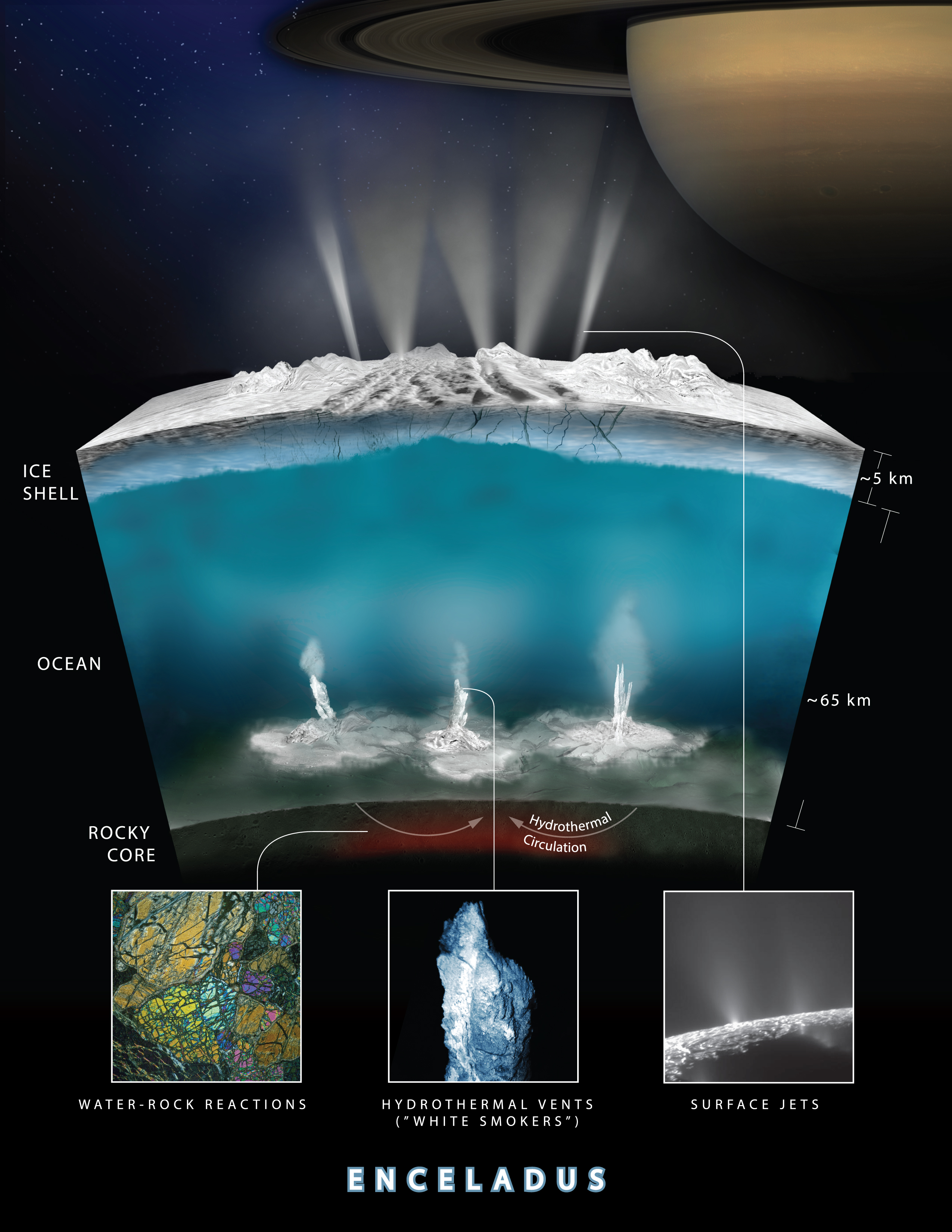New signs of life from Enceladus
In the geysers at Enceladus’ south pole, the hypothetical probe “Enceladus Life Finder” detects clear signs of life in my book “The Enceladus Mission” – whereupon a crewed spacecraft, the ILSE, is sent to Saturn’s moon. But it all really starts with Cassini, the NASA-ESA mission that found a relatively high concentration of certain molecules associated with hydrothermal vents at the bottom of Earth’s oceans, specifically hydrogen, methane and carbon dioxide, just there. The amount of methane found in the vapor plumes was particularly unexpected.
“We wanted to know: Could Earth-like microbes that ‘eat’ the hydrogen and produce methane explain the surprisingly large amount of methane Cassini discovered?” said Regis Ferriere, an associate professor in the Department of Ecology and Evolutionary Biology at the University of Arizona and one of the two lead authors of a new study published in Nature Astronomy. “Searching for such microbes, known as methanogens, on the seafloor of Enceladus would require extremely challenging deep-dive missions that are not in sight for several decades.” Ferriere and his team therefore chose a different, simpler path: they constructed mathematical models to calculate the likelihood that various processes, including biological methanogenesis, could explain the Cassini data.
On Earth, hydrothermal activity occurs when cold seawater seeps into the ocean floor, circulates through the underlying rock, and passes near a heat source, such as a magma chamber, before being spewed back into the water by hydrothermal vents. On Earth, methane can be produced in the process, but very slowly. Most of the production is due to microorganisms that use the chemical imbalance of hydrothermally produced hydrogen as an energy source, producing methane from carbon dioxide in a process known as methanogenesis.
The team considered the composition of Enceladus’ geysers to be the end result of several chemical and physical processes that must occur inside the moon. First, the researchers investigated which hydrothermal production of hydrogen would best fit Cassini’s observations and whether that production could provide enough “food” to sustain a population of Earth-like, hydrogenotrophic (hydrogen-eating) methane formers. To that end, they developed a model for the population dynamics of a hypothetical methane producer whose thermal and energetic niche was modeled after known strains from Earth. The authors then ran the model to see if a given set of chemical conditions, such as dihydrogen concentration in the hydrothermal fluid and temperature, would provide a suitable environment for these microbes to grow. They also examined what effects a hypothetical microbial population would have on their environment – for example, on the escape rates of hydrogen and methane in the geyser plume.
“In summary, not only were we able to assess whether Cassini’s observations are consistent with an environment habitable for life, but we were also able to make quantitative predictions about what we could expect to see should methanogenesis actually occur on Enceladus’ seafloor,” Ferriere explains. The results suggest that even the highest possible estimate of abiotic methane production – methane production without biological help – based on known hydrothermal chemistry is far from sufficient to explain the methane concentrations measured in the plumes. However, the addition of biological methanogenesis could produce enough methane to be consistent with Cassini’s observations.
“Of course, we are not claiming that life exists in Enceladus’ ocean,” Ferriere says. “However, we now know how likely it is that Enceladus’ hydrothermal vents could be habitable for Earth-like microorganisms. Very likely, at least based on the data provided by Cassini.” That doesn’t mean Enceladus harbors life. But if terrestrial methanogens succeeded in traveling there, they would likely find an environment conducive to life.

Hello sir,
I’ve read 4 of your books so far and I’m hooked. I started with The Hole and ofcourse, the references to the Enceladus mission made me want to jump into it (I just started Return to Enceladus). I’ve been impressed by the amount of scientific details and the realism.
The best work of sci-fi extrapolate on knowned science to guess possible outcome and you accomplish that brilliantly.
In the Ice moon serie, I was wondering if you considered the possible contamination of those moons by the ILSE crew members; knowing that micro-organism from earth could possibly survive on the ship, the lander and the EVA suits.
Perhaps it would have complicated things in the wrinting of those stories?
I also have an other question. As a science reporter, the technical aspects of writing where obviously not new to you. Was it hard for you to include the human interaction aspect to your writing and progressive story developpement (story building)?
I’m an ex reporter myself with writing ambitions so I’m rather curious on how others bridge the gap from reporter to writer.
Thank you for your time and thank you for your stories! I’m certain I will enjoy the rest of your work.
P.s. English is my second language, thank you for your comprehention on spelling mistakes 😉
Hello Jean-Nicolas, nice to hear from you! Regarding contamination – I assume a year in space will probably clean the outsides of a ship better than any human technology is able to. They are using SuitPorts to explore Enceladus so the suits are never brought inside, keeping away human germs.